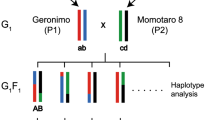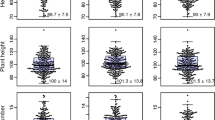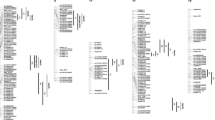Abstract
The power of QTL mapping by a mixed-model approach has been studied for hybrid crops but remains unknown in self-pollinated crops. Our objective was to evaluate the usefulness of mixed-model QTL mapping in the context of a breeding program for a self-pollinated crop. Specifically, we simulated a soybean (Glycine max L. Merr.) breeding program and applied a mixed-model approach that comprised three steps: variance component estimation, single-marker analyses, and multiple-marker analysis. Average power to detect QTL ranged from <1 to 47% depending on the significance level (0.01 or 0.0001), number of QTL (20 or 80), heritability of the trait (0.40 or 0.70), population size (600 or 1,200 inbreds), and number of markers (300 or 600). The corresponding false discovery rate ranged from 2 to 43%. Larger populations, higher heritability, and fewer QTL controlling the trait led to a substantial increase in power and to a reduction in the false discovery rate and bias. A stringent significance level reduced both the power and false discovery rate. There was greater power to detect major QTL than minor QTL. Power was higher and the false discovery rate was lower in hybrid crops than in self-pollinated crops. We conclude that mixed-model QTL mapping is useful for gene discovery in plant breeding programs of self-pollinated crops.

Similar content being viewed by others
References
Arbelbide M, Bernardo R (2005) Mixed-model QTL mapping for kernel hardness and dough strength in bread wheat. Theor Appl Genet (DOI 10.1007/s00122-005-0190-1)
Beavis WD (1994) The power and deceit of QTL experiments: lessons from comparative QTL studies. Proc Corn Sorghum Ind Res Conf 49:250–266
Beavis WD (1998) QTL analyses: power, precision, and accuracy. In: Paterson AH (ed) Molecular dissection of complex traits. CRC Press, Boca Raton , pp 145–162
Bernardo R (2004) What proportion of declared QTL in plants is false? Theor Appl Genet 109:419–424
Crepieux S, Lebreton C, Servin B, Charmet G (2004) Quantitative trait loci (QTL) detection in multicross inbred designs: recovering QTL identical-by descent status information from marker data. Genetics 168:1737–1749
Crepieux S, Lebreton C, Flament P, Charmet G (2005) Application of a new IBD-based mapping method to common wheat breeding population: analysis of kernel hardness and dough strength. Theor Appl Genet 111:1409–1419
Darvasi A, Weinreb A, Minke V, Weller JI, Soller M (1993) Detecting marker-QTL linkage and estimating QTL gene effect and map location using a saturated genetic map. Genetics 134:943–951
Delacy IH, Cooper M (1990) Pattern analysis for the analysis of regional variety trials. In: Kang MS (ed) Genotype-by-environment interaction and plant breeding. Louisiana State Univ Agr Cent, Baton Rouge
Delannay X, Rodgers DM, Palmer RG (1983) Relative genetic contributions among ancestral lines to north American soybean cultivars. Crop Sci 23:944–949
Emik LO, Terrill CE (1949) Systematic procedures for calculating inbreeding coefficients. J Hered 40:51–55
Farnir F, Coppieters W, Arranz J-J, Berzi P, Cambisano N, Grisart B, Karim L, Marcq F, Moreau L, Mni M, Nezer C, Simon P, Vanmanshoven P, Wagengaar D, Georges M (2000) Extensive linkage disequilibrium in cattle. Genome Res 10:220–227
George AW, Visscher PM, Haley CS (2000) Mapping quantitative traits in complex pedigrees: a two-step variance component approach. Genetics 156:2081–2092
Gizlice Z, Carter TE Jr, Burton JW (1994) Genetic base for north American public soybean cultivars released between 1947 and 1988. Crop Sci 34:1143–1151
Grupe A, Germer S, Usuka J, Aud D, Belknap JK, Klein RF, Ahluwalia MK, Higuchi R, Peltz G (2001) In silico mapping of complex disease-related traits in mice. Science 292:1915–1918
Haldane JBS, Waddington CH. (1931) Inbreeding and linkage. Genetics 16:357–374
Henderson CR (1984) Applications of linear models in animal breeding. University of Guelph, Ontario
Kearsey MJ, Farquhar AGL (1998) QTL analysis in plants; where are we now? Heredity 80:137–142
Kennedy BW, Quinton M, van Arendonk JAM (1992) Estimation of effects of single genes on quantitative traits. J Anim Sci 70:2000–2012
Lande R, Thompson R (1990) Efficiency of marker-assisted selection in the improvement of quantitative traits. Genetics 124:743–756
van Ooijen JW (1992) Accuracy of mapping quantitative trait loci in autogamous species. Theor Appl Genet 84:803–811
Parisseaux B, Bernardo R (2004) In silico mapping of quantitative trait loci in maize. Theor Appl Genet 109:508–514
Rebaï A, Goffinet B, Mangin B (1995) Comparing power of different methods for QTL detection. Biometrics 51:87–99
Smith JSC, Ertl DS, Orman BA (1995) Identification of maize varieties. In: Wrigley CW (ed) Identification of food-grain varieties. Am Assoc Cereal Chemists, St Paul, pp 253–264
Smith OS, Hoard K, Shaw F, Shaw R (1999) Prediction of single-cross performance. In: Coors JG, Pandey S (eds) The genetics and exploitation of heterosis in crops. Am Soc Agron Crop Sci, Crop Science Society of America, Madison, Wisconsin, pp 277–285
Smith S, Beavis W (1996) Molecular marker assisted breeding in a company environment. In: Sobral BWS (ed) The impact of plant molecular genetics. Birkhauser, Boston, pp 259–272
Song QJ, Marek LF, Shoemaker RC, Lark KG, Concibido VC, Delannay X, Spetch JE, Cregan PB (2004) A new integrated linkage map of the soybean. Theor Appl Genet 109:122–128
Whittaker JC, Thompson R, Visscher PM (1996) On the mapping of QTL by regression of phenotype on marker type. Heredity 77:23–32
Xu S, Atchley WR (1995) A random model approach to interval mapping of quantitative trait loci. Genetics 93:580–586
Yu J, Arbelbide M, Bernardo R (2005) Power of in silico QTL mapping from phenotypic, pedigree and marker data in a hybrid breeding program. Theor Appl Genet 110:1061–1067
Zhang Y-M, Mao Y, Xie C, Smith H, Luo L, Xu S (2005) Mapping QTL using naturally occurring genetic variance among commercial inbred lines of maize. Genetics 169:2267–2275
Zhu YL, Song QJ, Hyten DL, Van Tassell CP, Matukumalli LK, Grimm DR, Hyatt SM, Fickus EW, Young ND, Cregan PB (2003) Single-nucleotide polymorphisms in soybean. Genetics 163:1123–1134
Acknowledgments
The research was funded by the United States Department of Agriculture National Research Initiative Competitive Grants Program (Plant Genomics – Bioinformatics) and supported in part by the University of Minnesota Supercomputing Institute (UMSI). We thank Dr. Shuxia Zhang of UMSI for technical support.
Author information
Authors and Affiliations
Corresponding author
Additional information
Communicated by H. Becker
Rights and permissions
About this article
Cite this article
Arbelbide, M., Yu, J. & Bernardo, R. Power of mixed-model QTL mapping from phenotypic, pedigree and marker data in self-pollinated crops. Theor Appl Genet 112, 876–884 (2006). https://doi.org/10.1007/s00122-005-0189-7
Received:
Accepted:
Published:
Issue Date:
DOI: https://doi.org/10.1007/s00122-005-0189-7




